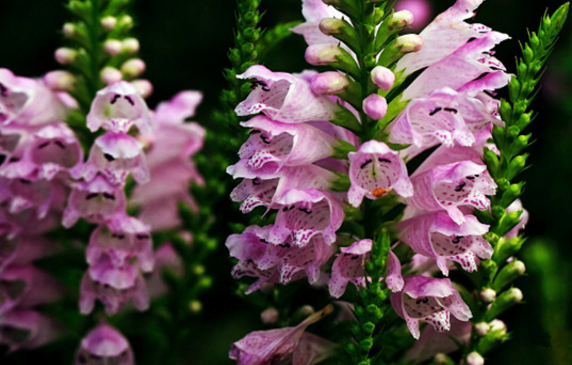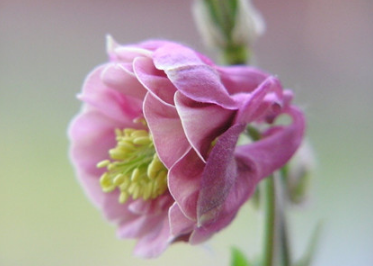The difference between marshmallow culture methods and matters needing attention and hollyhock
Mallow is a beautiful flower, the flower shape is more chic, and the color is more beautiful. Breeding mallow, we need to do a good job in daily work, watering and fertilization can not be careless.

Culture methods and matters needing attention of mallow
The culture method of mallow:
1. Soil
Mallow soil requirements are not high, you can choose sandy soil, or choose slightly acidic nutrient soil or rotten leaf soil, after the marshmallow pot, you need to put the sunflower pot in a sunny place for half a day, can promote its flowering.
2. Light and temperature
Sunflower likes the sunny environment, likes the cooler environment, can be cold-resistant. For breeding mallow, the suitable temperature for growth is between 18 ℃ and 25 ℃ to ensure plenty of sunshine. In the cold winter, the potted sunflower plants should be placed in a warm place with plenty of sunshine indoors, and the temperature should be kept at 3 ℃-5 ℃.
3. Watering and fertilizing
In terms of water and fertilizer, watering should pay attention to dry and avoid dampness, so as to avoid rotting roots, especially in cold winter and cool summer. Because the sunflower blossoms more and needs more nutrients, some nitrogen and phosphorus compound fertilizer can be applied during the growth period, and phosphate fertilizer is needed to promote flowering during flowering.
4. Methods of reproduction
The propagation of mallow is generally done by cutting and striping. Cuttings can choose robust branches, which will take root in a month or so. There are mainly two kinds of strip pressing method: high pressure method and ordinary pressing method.
Matters needing attention in marshmallow culture:
1. Pruning
In the growth process of mallow, it is necessary to prune the withered, diseased and weak branches, dense branches and residual flowers, which is beneficial to ventilation and light, and promote the branching and flowering of mallow.
2. Diseases and insect pests and their control
Mallow in the maintenance process will appear some diseases, mainly coal fouling disease, can be sprayed with chemicals, and pay attention to ventilation to avoid diseases. Mallow sometimes encounters insect pests in the process of maintenance, mainly aphids and shell insects. When these pests occur in mallow, it can be sprayed with 2000 times the liquid of omethoate.
The difference between hollyhock and hollyhock
Plant morphology of the difference between marshmallow and hollyhock
Mallow is a biennial or perennial erect herb with a height of about 50-90 cm, much branched and sparsely hirsute. The hollyhock is a biennial erect herb, the plant is much taller than the sunflower, up to 2 meters high, and the stems and branches are densely bristled.
1. The leaf morphology of the difference between mallow and hollyhock.
The leaves of hollyhocks are larger than those of marshmallows, and the petioles of hollyhocks are much longer than those of mallow.
The leaves of mallow are glabrous or only strigillose on both sides, while hollyhocks are hairy on both sides, sparsely stellate pilose above, rough, and stellate hirsute or tomentose underneath.
Sunflower stipules apex acuminate; hollyhock stipules apex 3-pointed.
2. The flower shape of the difference between sunflower and hollyhock.
The flowers of marshmallow are small and monotonous, usually purple and pink, while the flowers of hollyhock are large and rich in color, such as white, red, pink and yellow. The flowering period of hollyhock is from June to August and the flowering period of sunflower is from May to October.
Guys, now you can tell the difference between mallow and hollyhock.
Culture methods and matters needing attention of medicinal hollyhock
Latin name A. officinalis
Binomial method Althaea officinalis L.
The plant kingdom.
Phylum angiosperm
Dicotyledonous class
Order Malvaceae
Malvaceae of Malvaceae
Althaea of hollyhock
Grow medicine hollyhock
The distribution area is born on the edge of the field, roadside and wilderness.
Herbs perennial, about 1 meter tall. Stem erect, densely stellate hirsute. Stipules small, striate, ca. 0.5 cm long; petiole 1 mm long, densely stellate tomentose, leaf blade ovoid or broadly ovate, usually undivided, a few 3-lobed, base subcordate to rounded, apex obtuse, margin serrate, both surfaces densely stellate tomentose
1. Basic information
English name: medicine hollyhock
Latin name: Althaea officinalis L.
Family name: Malvaceae of Malvaceae
Chinese medicine name: medicine hollyhock
Habitat: born on the edge of the field, roadside and wilderness.
2. Morphological characteristics.
Herbs perennial, about 1 meter tall. Stem erect, densely stellate hirsute. Stipules small, striate, ca. 0.5 cm; petiole 1mm long, densely stellate tomentose, leaf blade ovoid or broadly ovate, usually undivided, a few 3-lobed, base subcordate to rounded, apex obtuse, margin serrate, both surfaces densely stellate tomentose; calyx cup-shaped, persistent, 5-lobed, lobes lanceolate, ca. 1 cm long, stellate tomentose densely; flowers reddish, 23 cm in diam. Petals 5, Obovate moment round; stamens numerous, filaments connected with synthetic tube; carpels numerous. Fruit disk-shaped, 6 mi 8 mm in diam., each carpel separated from axis when ripe. Seeds reniform, reddish brown, 2 mm long. The florescence is from June to August and the fruiting period is from August to September.
3. Medicinal value
Medicinal part: root
Medicinal ingredients: contains mucus, pectin, starch and sugar.
Function and indications: it has the function of relieving surface and dispelling cold, diuresis, relieving cough, anti-inflammation and detoxification. Treat sore, furuncle, carbuncle, cough, tracheitis and wind-cold, etc.
How to raise hollyhocks? Culture methods and matters needing attention of hollyhock
Hollyhock, also known as Yi Zhanghong, Da Shu Ji, Wu Kui, etc., is a biennial erect herb of the genus Hollyhock of Malvaceae. The flowers and colors of hollyhocks are rich, fresh and elegant, or colorful, with high ornamental value, so they are often potted in the indoor courtyard. So, how to raise hollyhocks? The breeding methods and matters needing attention of hollyhock are introduced as follows.
Picture: hollyhock
1. Culture methods of hollyhock
1. Lighting: hollyhocks like sunny environment and withstand semi-shade. At ordinary times, hollyhocks should be placed in a place where the sun shines directly and be exposed to sunlight.
two。 Temperature: the hollyhock is hardy, and the upper branches wither and die in winter, but the underground roots can survive the winter in the open field and sprout again next year. You can safely spend the winter in the open field in North China. The growth temperature of hollyhock is 25 ℃-30 ℃, and the most suitable temperature for flowering is 26 ℃-28 ℃. The monthly average temperature is lower than 17 ℃, and the night temperature is lower than 14 ℃.
3. Watering: usually pay attention to watering, keep the soil moist, but not overwatering, hollyhock afraid of waterlogging. Hollyhocks should be properly watered during flowering so as to prolong flowering period and increase flower quantity.
4. Soil: hollyhock has strong adaptability to soil, strong saline-alkali tolerance, and can still grow in soil containing 0.6% salt. The growth trend is the best in the sandy soil with loose and fertile, good drainage and rich organic matter.
5. Fertilization: before planting hollyhocks, dig deep into the soil and add base fertilizer to the soil. During the growth period, liquid fertilizer mainly composed of nitrogen and potash was applied once or twice. After the formation of flower buds, the liquid fertilizer mainly composed of phosphorus and potassium fertilizer was applied once or twice.
Picture: hollyhock
II. Matters needing attention in hollyhock culture
1. Timely pruning: after the hollyhock blossoms, cut off the part of the ground in time, and new buds can sprout.
two。 Summer shade: due to strong light in summer, hollyhocks should not be exposed to the sun as far as possible, so as not to affect plant growth, should be appropriate shade, absorb scattered light.
3. Control plant height: in order to dwarf the plant, root cutting can be used to control the height, that is, the root is cut vertically at the left and right 10 cm of the plant root during the growth period, and then cut again 3 weeks after cutting. The more times the root is cut, the shorter the plant will be, which is suitable for potted plants.
[editor's conclusion] Hollyhock likes sunny environment and can withstand semi-shade, but avoid waterlogging, so special attention should be paid to it in the process of maintenance. The above introduces the cultivation methods and matters needing attention of hollyhock, hoping to help you!
- Prev

A complete list of breeding methods for random grass
Random grass is also called Zhi Serratula, false dragon head, tiger tail flower, etc. White, deep pink, rose red, snow green and other colors, very suitable as ornamental plants. It is widely distributed in eastern China. Today, Xiaobian will take you to see random grass. The method of cultivation of random grass is another name for random grass.
- Next

When to blossom and culture methods and points for attention of Euphorbia angustifolia
Euphorbia angustifolia, a kind of beautiful flowering, is more suitable for breeding in the courtyard. As a highly ornamental plant, being praised is the best fertile soil. Why don't you go and see what it is like. When does it blossom? when does it blossom? the flowering time of Hedyotis chinensis
Related
- Fuxing push coffee new agricultural production and marketing class: lack of small-scale processing plants
- Jujube rice field leisure farm deep ploughing Yilan for five years to create a space for organic food and play
- Nongyu Farm-A trial of organic papaya for brave women with advanced technology
- Four points for attention in the prevention and control of diseases and insect pests of edible fungi
- How to add nutrient solution to Edible Fungi
- Is there any good way to control edible fungus mites?
- Open Inoculation Technology of Edible Fungi
- Is there any clever way to use fertilizer for edible fungus in winter?
- What agents are used to kill the pathogens of edible fungi in the mushroom shed?
- Rapid drying of Edible Fungi

